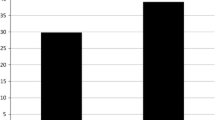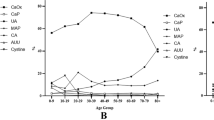Abstract
Few studies have examined the relative risk of recurrence of different stone types. The object of the present study was to evaluate the tendency for stone recurrence as a function of major mineral composition of the stones and morphological characteristics of the stones. This study was carried out using 38,274 stones for which we had data available to specify if the stone was from the first or a subsequent urinary stone episode. Stones were analyzed for morphology by stereomicroscope and for composition by infrared spectroscopy. Overall, 42.7% of stones were from patients who had had a previous stone event, with these being more frequent in men (44.4%) than in women (38.9%, p < 0.0001). Age of first stone occurrence was lowest for dihydroxyadenine (15.7 ± 16.6 years) and highest for anhydrous uric acid (62.5 ± 14.9 years), with the average age of first stones of calcium oxalate falling in the middle (40.7 ± 14.6 years for calcium oxalate dihydrate, and 48.4 ± 15.1 years for calcium oxalate monohydrate, COM). By composition alone, COM was among the least recurrent of stones, with only 38.0% of COM stones coming from patients who had had a previous episode; however, when the different morphological types of COM were considered, type Ic—which displays a light color, budding surface and unorganized section—had a significantly greater rate of recurrence, at 82.4% (p < 0.0001), than did other morphologies of COM. Similarly, for stones composed of apatite, morphological type IVa2—a unique form with cracks visible beneath a glossy surface—had a higher rate of recurrence than other apatite morphologies (78.8 vs. 39–42%, p < 0.0001). Stone mineral type alone is insufficient for identifying the potential of recurrence of the stones. Instead, the addition of stone morphology may allow the diagnosis of highly recurrent stones, even among common mineral types (e.g., COM) that in general are less recurrent.




Similar content being viewed by others
References
Ljunghall S, Lithell H, Skarfors E (1987) Prevalence of renal stones in 60-year-old men. A 10-year follow-up study of a health survey. Br J Urol 60:10–13
Ahlstrand C, Tiselius HG (1990) Recurrences during a 10-year follow-up after first renal stone episode. Urol Res 18:397–399
Ulmann A, Clavel J, Destree D, Dubois C, Mombet A, Brisset JM (1991) Histoire naturelle de la lithiase rénale calcique: données obtenues à partir d’une cohorte de 667 malades. Presse Med 20:499–502
Chow GK, Streem SB (1998) Contemporary urological intervention for cystinuric patients: immediate and long-term impact and implications. J Urol 160:341–344 (discussion 344–345)
Millman S, Strauss AL, Parks JH, Coe FL (1982) Pathogenesis and clinical course of mixed calcium oxalate and uric acid nephrolithiasis. Kidney Int 22:366–370
Koide T, Itatani H, Yoshioka T et al (1982) Clinical manifestations of calcium oxalate monohydrate and dihydraté urolithiasis. J Urol 127:1067–1069
Ohman S, Larsson L, Tiselius HG (1992) Clinical significance of phosphate in calcium oxalate renal stones. Ann Clin Biochem 29:59–63
Daudon M, Protat MF, Réveillaud RJ (1978) Analysis of calculi by infrared spectrophotometry. Advantages and limits of the method. Ann Biol Clin 36:475–489
Daudon M, Bader CA, Jungers P (1993) Urinary calculi: review of classification methods and correlations with etiology. Scanning Microsc 7:1081–1106
Daudon M, Jungers P (2012) Stone composition and morphology: a window on etiology. In: Talati JJ, Tiselius HG, Albala DM, Ye Z (eds) Urolithiasis: basic science and clinical practice. Springer, London, pp 113–140
Daudon M, Donsimoni R, Hennequin C, Fellahi S, Le Moël G, Paris M et al (1995) Sex and age-related composition of 10617 calculi analyzed by infrared-spectroscopy. Urol Res 23:319–326
Daudon M, Réveillaud RJ (1984) Whewellite and weddellite: toward a different etiopathogenesis. The significance of morphological typing of calculi. Néphrologie 5:195–201
Asplin JR, Lingeman JE, Kahnoski R, Mardis H, Parks JH, Coe. FL (1998) Metabolic urinary correlates of calcium oxalate dihydrate in renal stones. J Urol 159: 664–668
Parent X, Boess G, Brignon P (1999) Calcium oxalate stones. Relationship between biochemical risk factors and crystalline phase of the stone. Prog Urol 9:1051–1056
Mandel NS, Mandel GS (1989) Urinary tract stone disease in the United States veteran population. II. Geographical analysis of variations in composition. J Urol 142:1516–1521
Brien G, Schubert G, Bick C (1982) 10,000 analyses of urinary calculi using X-ray diffraction and polarizing microscopy. Eur Urol 8:251–256
Moran ME (2003) Uric acid stone disease. Front in Biosci 8:1339–1355
Klee LW, Brito CG, Lingeman JE (1991) The clinical implications of brushite calculi. J Urol 145:715–718
Parks JH, Worcester EM, Coe FL, Evan AP, Lingeman JE (2004) Clinical implications of abundant calcium phosphate in routinely analyzed kidney stones. Kidney Int 66:777–785
Evan AP, Lingeman JE, Coe FL et al (2005) Crystal-associated nephropathy in patients with brushite nephrolithiasis. Kidney Int 67:576–591
Stamatelou KK, Francis ME, Jones CA, Nyberg LM Jr, Curhan GC (2003) Time trends in reported prevalence of kidney stones in the United States: 1976–1994. Kidney Int 63:1817–1823
Hesse A, Brandle E, Wilbert D, Kohrmann KU, Alken P (2003) Study on the prevalence and incidence of urolithiasis in Germany comparing the years 1979 vs. 2000. Eur Urol 44:709–713
Trinchieri A, Coppi F, Montanari E, Del Nero A, Zanetti G, Pisani E (2000) Increase in the prevalence of symptomatic upper urinary tract stones during the last ten years. Eur Urol 37:23–25
Gagné ER, Deland E, Daudon M, Noel L-H, Nawar T (1994) Chronic renal failure secondary to 2,8-dihydroxyadenine deposition: the first report of recurrence in a kidney transplant. Am J Kidney Dis 24:104–107
de Jong DJ, Assmann KJ, De Abreu RA et al (1996) 2,8-Dihydroxyadenine stone formation in a renal transplant recipient due to adenine phosphoribosyltransferase deficiency. J Urol 156:1754–1755
Glicklich D, Gruber HE, Matas AJ et al (1988) 2,8-Dihydroxyadenine urolithiasis: report of a case first diagnosed after renal transplant. Q J Med 68:785–793
Stratta P, Fogazzi GB, Canavese C et al (2010) Decreased kidney function and crystal deposition in the tubules after kidney transplant. Am J Kidney Dis 56:585–590
Singer A, Das A (1989) Cystinuria: a review of the pathophysiology and management. J Urol 142:669–673
Prot-Bertoye C, Lebbah S, Daudon M et al (2015) CKD and its risk factors among patients with cystinuria. Clin J Am Soc Nephrol 10:842–851
Maurice-Estepa L, Levillain P, Lacour B, Daudon M (1999) Crystalline phase differentiation in urinary calcium phosphate and magnesium phosphate calculi. Scand J Urol Nephrol 33:299–305
Daudon M, Jungers P (2004) Clinical value of crystalluria and quantitative morphoconstitutional analysis of urinary calculi. Nephron Physiol 98:31–36
Koide T, Itatani H, Yoshioka T et al (1982) Clinical manifestations of calcium oxalate monohydrate and dihydrate urolithiasis. J Urol 127:1067–1069
Daudon M, Lacour B, Jungers P (2006) Influence of body size on urinary stone composition in men and women. Urol Res 34:193–199
Daudon M, Traxer O, Conort P, Lacour B, Jungers P (2006) Type 2 diabetes increases the risk for uric acid stones. J Am Soc Nephrol 17:2026–2033
Tasian GE, Kabarriti AE, Kalmus A, Furth SL (2017) Kidney stone recurrence among children and adolescents. J Urol 197:246–252
Khan SR, Pearle MS, Robertson WG et al (2016) Kidney stones. Nat Rev Dis Primers 2:16008
Normand M, Bergua D, Bouvet JP, Cayotte JL, Gottis M (1989) Correlations between the cause and the composition of urinary stones - the interest of morphological and infrared analysis. Ann Biol Clin 7:29–34
Daudon M, Doré JC, Jungers P, Lacour B (2004) Changes in stone composition according to age and gender of patients: a multivariate epidemiological approach. Urol Res 32:241–247
Daudon M (2005) Epidemiology of nephrolithiasis in France. Ann Urol 39:209–231
Moses R, Pais VM Jr, Ursiny M, Prien EL Jr, Miller N, Eisner BH (2015) Changes in stone composition over the two decades: evaluation of over 10,000 stone analyses. Urolithiasis 43:135–139
Soble JJ, Hamilton BD, Streem SB (1999) Ammonium acid urate calculi: a reevaluation of risk factors. J Urol 161:869–873
Kuruma H, Arakawa T, Kubo S et al (2006) Ammonium acid urate urolithiasis in Japan. Int J Urol 13:498–501
Méria P, Hadjadj H, Jungers P, Daudon M, Members of the Urolithiasis Committee of the French Urological Association (2010) Stone formation and pregnancy: pathophysiological insights gained from morphoconstitutional stone analysis. J Urol 183: 1412–1416
Abate N, Chandalia M, Cabo-Chan AV Jr, Moe OW, Sakhaee K (2004) The metabolic syndrome and uric acid nephrolithiasis: novel features of renal manifestation of insulin resistance. Kidney Int 65:386–392
Williams JC Jr, Saw KC, Paterson RF, Hatt EK, McAteer JA, Lingeman JE (2003) Variability of renal stone fragility in shock wave lithotripsy. Urology 61:1092–1096
Daudon M, Bouzidi H, Bazin D (2010) Composition and morphology of phosphate stones and their relation with etiology. Urol Res 38:459–467
Mandel N, Mandel I, Fryjoff K, Rejniak T, Mandel G (2003) Conversion of calcium oxalate to calcium phosphate with recurrent stone episodes. J Urol 169:2026–2029
Dessombz A, Letavernier E, Haymann JP, Bazin D, Daudon M (2015) Calcium phosphate stone morphology can reliably predict distal renal tubular acidosis. J Urol 193:1564–1569
Low RK, Stoller ML (1997) Endoscopic mapping of renal papillae for Randall’s plaques in patients with urinary stone disease. J Urol 158:2062–2064
Evan AP, Lingeman JE, Coe FL et al (2003) Randall’s plaque of patients with nephrolithiasis begins in basement membranes of thin loops of Henle. J Clin Invest 111:607–616
Daudon M, Bazin D, Letavernier E (2015) Randall’s plaque as the origin of calcium oxalate kidney stones. Urolithiasis 43(S1):5–11
Kim SC, Coe FL, Tinmouth WW et al (2005) Stone formation is proportional to papillary surface coverage by Randall’s plaque. J Urol 173:117–119
Matlaga BR, Williams JC Jr, Kim SC et al (2006) Endoscopic evidence of calculus attachment to Randall’s plaque. J Urol 175:1720–1724
Author information
Authors and Affiliations
Corresponding author
Ethics declarations
Conflict of interest
The authors declare no conflict of interest.
Ethical approval
All the specimens of our database were de-identified. All procedures performed in the study were in accordance with the ethical standards of the institutional research committee.
Informed consent
Informed consent was obtained from all individual participants.
Rights and permissions
About this article
Cite this article
Daudon, M., Jungers, P., Bazin, D. et al. Recurrence rates of urinary calculi according to stone composition and morphology. Urolithiasis 46, 459–470 (2018). https://doi.org/10.1007/s00240-018-1043-0
Received:
Accepted:
Published:
Issue Date:
DOI: https://doi.org/10.1007/s00240-018-1043-0




